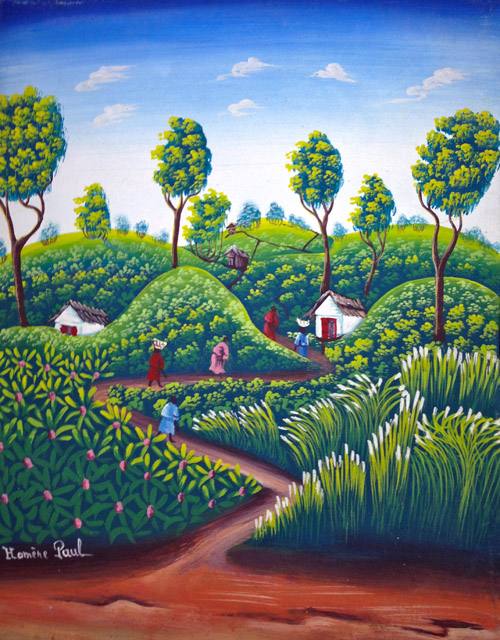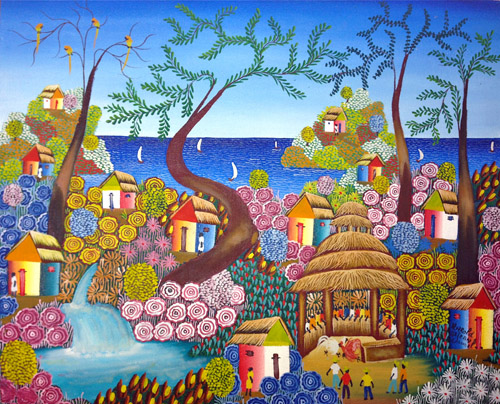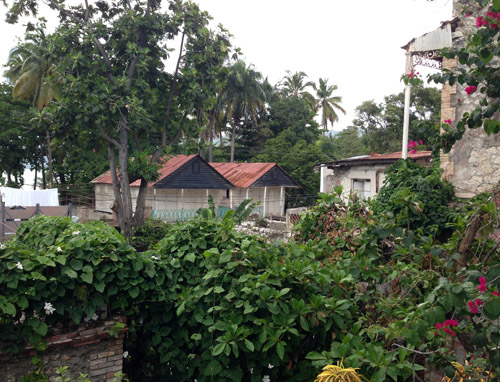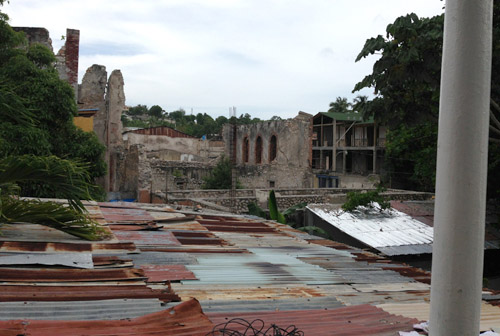By Mary Jane Buchanan
All Saints Outreach Committee
 The character of Jacmel in Haiti is heavy and thick and sticky like molassas. The red-orange color of coral tree flowers with waxed green leaves look liquid, dripping over brick walls and iron balconies. Once the coffee and cigar treasury of the world, much of what Jacmel is today was built near the end of the nineteenth century. The Hotel Florita, established 1888, predates the fire of 1896, which destroyed most buildings in the city. Brick warehouses remaining from the days of the coffee and cigar trade arch over sidewalks along the streets of the downtown. Cast-iron pillars and balconies shipped from France after the 1896 fire remain a pronounced architectural feature reminiscent of pre-Katrina New Orleans.
The character of Jacmel in Haiti is heavy and thick and sticky like molassas. The red-orange color of coral tree flowers with waxed green leaves look liquid, dripping over brick walls and iron balconies. Once the coffee and cigar treasury of the world, much of what Jacmel is today was built near the end of the nineteenth century. The Hotel Florita, established 1888, predates the fire of 1896, which destroyed most buildings in the city. Brick warehouses remaining from the days of the coffee and cigar trade arch over sidewalks along the streets of the downtown. Cast-iron pillars and balconies shipped from France after the 1896 fire remain a pronounced architectural feature reminiscent of pre-Katrina New Orleans.
We have come to Jacmel for the art: There is honesty in art that speaks clearly of the people who create it. These are bits and pieces of Haiti that we can bring back to share. Our guide, Dr. Serena Beeks of the Los Angeles Diocese, takes us to a narrow street in the downtown area a short distance from the harbor beach. It is hot, and the few people on the street sit in quiet groups in the shade near the shops and houses. It is not always easy to  distinguish between shop and house as many serve as both, and windows are frequently cookie cutter brick lattice allowing air to pass while keeping the inside dark and private. The outstanding exception is the papier-mache studio. We are warmly greeted by the artist/proprietor. Cow heads adorned with swirling collages of kaleidoscope color and patterns hang from the covered porch ceiling. Lion, leopard and dragon heads with Halloween manes, bristle whiskers
distinguish between shop and house as many serve as both, and windows are frequently cookie cutter brick lattice allowing air to pass while keeping the inside dark and private. The outstanding exception is the papier-mache studio. We are warmly greeted by the artist/proprietor. Cow heads adorned with swirling collages of kaleidoscope color and patterns hang from the covered porch ceiling. Lion, leopard and dragon heads with Halloween manes, bristle whiskers  and scarlet tongues bob like corks. Inside, the smell of paint and varnish is strong to the point of stifling. Serena and I both choose playful cow heads; and Syd, a snarling dragon beast.
and scarlet tongues bob like corks. Inside, the smell of paint and varnish is strong to the point of stifling. Serena and I both choose playful cow heads; and Syd, a snarling dragon beast.
Walking into the art shop filled with Harold St. Jean and Homere Paul paintings was like Dorothy waking in the Land of Oz. From floor to ceiling, canvases crowded with Haitian life and landscape in flat acrylic color. 
The repetition of pattern, contrasting color and line, details drawn like short story in themselves keep the eye moving, moving, moving across the canvas, resting on intimate vignettes then to the top of the canvas of always blue sky, above blue water and islands. Critical opinion would observe that the canvas may be discarded sail cloth, the frame corners often tilt at less than perfect right angle, glued or nailed together, and the inexpensive acrylic paint closely mimics the tempera water paint typical of early Haitian art.


Our last look is from the balcony of the Florita Hotel towards the Bay of Jacmel. To the right is the lush vegetation that trims the sand beach of the bay. To the left are the ruins of Jacmel, jagged, rusted and heavy. Clean sheets drawn across bowed clotheslines are the only reminder that people live within.
The Road to St. Cyprien ~ To Be Continued ~ 